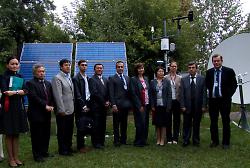Official inauguration of the regional Hymet monitoring network in Bishkek
On Friday, 16 September 2011, GFZ and CAIAG presented the first part of the regional hydrometeorological monitoring network being established in the frame of the CAWa project. Representatives of the German Federal Foreign Office, the Ministry of Foreign Affairs of the Kyrgyz Republic, as well as the Kyrgyz Ministry of Emergency Situations participated in the official inauguration ceremony which was held in Bishkek.
Water in Central Asia’s fragile geo-system
Measurements to determine processes in high-altitude mountains


On 16.09.2011 in Bishkek, the capital of the Kyrgyz Republic, German and Central Asian scientists officially launched the network of hydrometeorological monitoring stations in Kyrgyzstan (Baitik, Taragai, Kokemeren, Abramov glacier) which comprises low-maintenance, automated stations with remote-retrieval of data and a facility for remote-maintenance.The stations are, therefore, most suitable for operation in high-altitude regions, e.g. at the Abramov glacier in the Alai mountains situated 4100 m NN. The monitoring stations were developed by the GFZ German Research Centre for Geosciences (Helmholtz Association) and installed together with scientists from the Central Asian Institute for Applied Geosciences (CAIAG). The monitoring network is part of the research work of the“Water in Central Asia”project CAWa, which was initiated in 2008 by the Foreign Office of the Federal Republic of Germany within theframework of the „Berlin Process”.
In the presence of the German Ambassador in Kyrgyzstan, Gudrun Sräga, the Minister for Emergency Situations of the Kyrgyz Republic, Bolotbek Borbiev, the Kyrgyz Deputy Foreign Minister, Dinara Kemelova, representatives of the embassies of Central Asian states as well as representatives from CAIAG and the GFZ, the monitoring stations were officially launched with a symbolic ceremony at CAIAG. The project „Water in Central Asia“ (CAWa) which is being funded by the Foreign Office of the Federal Republic of Germany will, under theleadership of the scientists from the GFZ, process the obtained data and provide the data as well as the results of the analysis to the Central Asian states.
With this CAWa makes a significant contribution to the development of a reliable and long-term scientific database together with a technical infrastructure in the water sector for Central Asia. This is a key prerequisite for the development of a sustainable water management in the region and for the establishment and operation of early warning systems for flood hazards. The data of the new high-tech stations have high-resolution in time and are transmitted via satellite in near real-time. They can be applied for weather forecasting as well as for scientific investigations such as the assessment of climate change or the monitoring of high-altitude glaciers.
Water as a geo resourc eis a critical environmental and economic factor in Central Asia. Monitoring of available water quantities, of their use for agricultural purposes and in the energy sector as well as monitoring of water-related natural hazards are of decisive importance for all states in the region. To date, however, the required observation data are patchy and incomplete: After the collapse of the Soviet Union the number of meteorological stations in Kyrgyzstan declined from 83 stations in the year 1986 to 30 in the year 2005, the number of discharge gauges sank during the same time period from 152 to 76. In other countries of the region the situation is similar. Sinceobservation in the higher located mountainous regionswas complex and funding was not available, the systematic observations decreased especiallyin the headwater catchments which are crucial for the formation of available water resources.
To adequately tackle the geo-problems of the region the GFZ German Research Centre for Geosciences and the KyrgyzRepublic founded, in 2002, the Central Asian Institute for Applied Geosciences, where the hydrometeorological data now are collected and processed. The German Co-Director of CAIAG, Dr. Jörn Lauterjung from the GFZ, states on the occasion of the inauguration of the new stations: “Hydrometeorological observations are essential for water management, but also for the establishment of forecastingprocedures as a basis for future decision-making processes in the region. They combine weather forecasting, run-offforecast and the seasonal prediction on expected water availabilityin the vegetation period.” His Kyrgyz partner, Co-Director Dr. Bolot Moldobekov agrees with him: “An important component hereis the establishment of a modern, automated, regional monitoring network which can deliver reliable data on the weather, and run-off events within seconds. During the first and second phases of the CAWa-Project four monitoring stations have been installed up to now in the Kyrgyz Republic.”
In the following phase, the network is to be expanded to other states of Central Asia, as the water issues can only be solved across borders – one of the reasons why the German Federal Foreign Office allocated funding for the CAWa-Project. It strengthens the cooperation between Central Asia, Germany and international scientists and institutions. In this way,it considerably contributes to the development of a reliable scientific and technical basis of data forassessment of available water resources, the climate change and natural hazard potential in Central Asia. The activities include, in particular, the training and education of specialists from the Central Asian hydrometeorological service. Especially for CAWa a system of courses for training- and education was developed which are held in central Asia and at the GFZ in Potsdam.
Attachments:
Submitted by Katy Unger-Shayesteh on